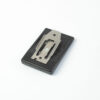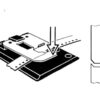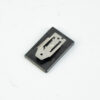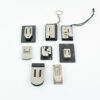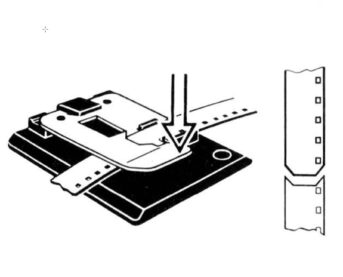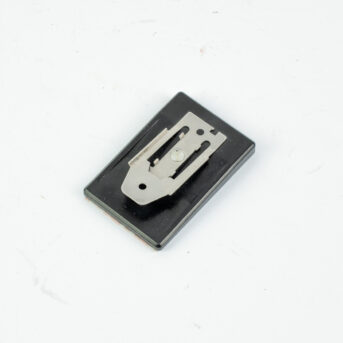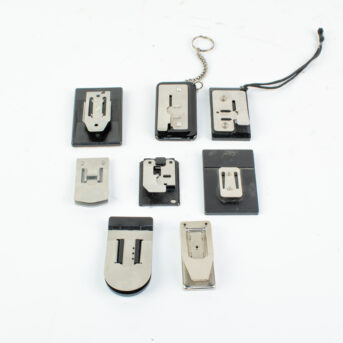Film cutter – angular – 8mm / super 8 (used)
€ 8,95
Film cutter – angular – 8mm / super 8 (used)
Use the cutter to neatly cut off the end of the lead-in strip.
SKU: SP-1018
Categories: Archive film, Film, Film and slides, Film leaders, Splicers
21 in stock
Recommended combination
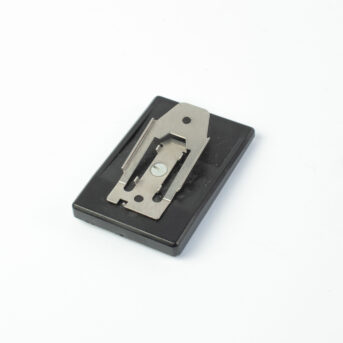
This item: Film cutter - angular - 8mm / super 8 (used)
21 in stock
€ 8,95
€ 8,95
Description
Film cutter – angular – 8mm / super 8 (used)
Use the cutter to neatly cut off the end of the lead-in strip.
Suitable for 8mm / super 8 film
Rounding: angular: for cutting a straight cut with an angular rounding on both sides.
Various versions of this type of product have been made. This is a used product and the exact type that is supplied depends on what is available.
Depending on the brand/type of projector that is used, the beginning of the lead-in strip must have a certain shape. This is often stated in the user manual of the film projector. The three most commonly used shapes for this are: – straight, angular and round.
To make this shape, it is best to use a film cutter.
Preparing a Film for Playback or Digitization
(If you have your films digitized by Van Eck Video Services, you do not need to do this yourself—this is included by default with the film transfer/digitization service.)
1. Use of Leader and Trailer Strips
Leader and trailer strips are empty pieces of film attached to the beginning (leader) and end (trailer) of a film. They serve several important functions:
Protection: They prevent the first frames of the actual film from being damaged during threading into the projector.
Ease of threading: The projector can more easily pick up the film and transport it correctly.
Stability: The leader allows the projector to reach the correct speed and stability before the actual image begins.
Identification: Different colors are often used (e.g., white or transparent for the beginning, red for the end) to clearly indicate where the film starts or ends.
👉 Make sure the leader strip is long enough (approximately 60–90 cm is ideal).
👉 Depending on the brand/type of projector used, the beginning of the leader may need to have a specific shape. This is usually indicated in the projector’s manual. The three most commonly used shapes are: straight, angled, and rounded.
To create this shape, it's best to use a film trimmer. Sometimes this is built into the projector, but separate trimmers are also available:
2. Film and Splice Inspection
Before playing the film, it is important to inspect it thoroughly.
What to check:
Tears or holes near the perforations: These can cause transport issues or film jams.
Splices: These are the connections between two pieces of film, often made using tape or film cement/splicing glue.
What to do with splices:
Carefully test their strength. Gently pull on both sides of the splice to check if it still holds well.
Ensure the splice lies flat. A splice that is too thick may cause jams during projection.
Replace old or weak splices. Use a splicer and the appropriate tape or cement.
3. Using a Splicer
A splicer is a device used to neatly join film strips together.
Functions:
Cuts the film straight so both ends align properly.
Aligns perforations for smooth transport through the projector.
Applies tape or cement accurately to create a strong, flat connection.
Tips:
Clean the splicer regularly.
Practice on a piece of old film if you have no prior experience.
4. Other Important Preparations
Clean the projector—especially the sprockets, film guides, and lens.
Use a film cleaner to remove dust and dirt from the film.
Optionally, use a film rewinder to evenly wind the film after playback.
By carefully following these steps, you will extend the lifespan of your Super 8 film and ensure a stable, trouble-free projection.
Film cutter – angular – 8mm / super 8 (used)
Use the cutter to neatly cut off the end of the lead-in strip.
Suitable for 8mm / super 8 film
Rounding: angular: for cutting a straight cut with an angular rounding on both sides.
Various versions of this type of product have been made. This is a used product and the exact type that is supplied depends on what is available.
Depending on the brand/type of projector that is used, the beginning of the lead-in strip must have a certain shape. This is often stated in the user manual of the film projector. The three most commonly used shapes for this are: – straight, angular and round.
To make this shape, it is best to use a film cutter.
Preparing a Film for Playback or Digitization
(If you have your films digitized by Van Eck Video Services, you do not need to do this yourself—this is included by default with the film transfer/digitization service.)
1. Use of Leader and Trailer Strips
Leader and trailer strips are empty pieces of film attached to the beginning (leader) and end (trailer) of a film. They serve several important functions:
Protection: They prevent the first frames of the actual film from being damaged during threading into the projector.
Ease of threading: The projector can more easily pick up the film and transport it correctly.
Stability: The leader allows the projector to reach the correct speed and stability before the actual image begins.
Identification: Different colors are often used (e.g., white or transparent for the beginning, red for the end) to clearly indicate where the film starts or ends.
👉 Make sure the leader strip is long enough (approximately 60–90 cm is ideal).
👉 Depending on the brand/type of projector used, the beginning of the leader may need to have a specific shape. This is usually indicated in the projector’s manual. The three most commonly used shapes are: straight, angled, and rounded.
To create this shape, it's best to use a film trimmer. Sometimes this is built into the projector, but separate trimmers are also available:
2. Film and Splice Inspection
Before playing the film, it is important to inspect it thoroughly.
What to check:
Tears or holes near the perforations: These can cause transport issues or film jams.
Splices: These are the connections between two pieces of film, often made using tape or film cement/splicing glue.
What to do with splices:
Carefully test their strength. Gently pull on both sides of the splice to check if it still holds well.
Ensure the splice lies flat. A splice that is too thick may cause jams during projection.
Replace old or weak splices. Use a splicer and the appropriate tape or cement.
3. Using a Splicer
A splicer is a device used to neatly join film strips together.
Functions:
Cuts the film straight so both ends align properly.
Aligns perforations for smooth transport through the projector.
Applies tape or cement accurately to create a strong, flat connection.
Tips:
Clean the splicer regularly.
Practice on a piece of old film if you have no prior experience.
4. Other Important Preparations
Clean the projector—especially the sprockets, film guides, and lens.
Use a film cleaner to remove dust and dirt from the film.
Optionally, use a film rewinder to evenly wind the film after playback.
By carefully following these steps, you will extend the lifespan of your Super 8 film and ensure a stable, trouble-free projection.





